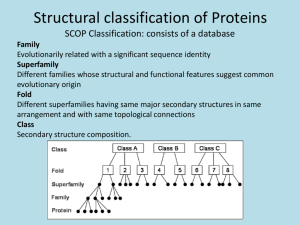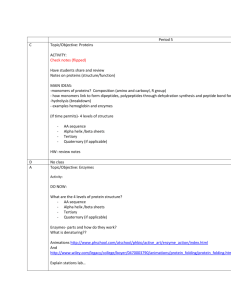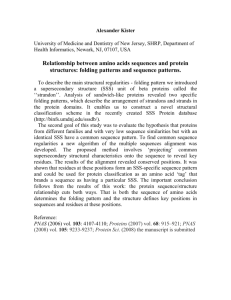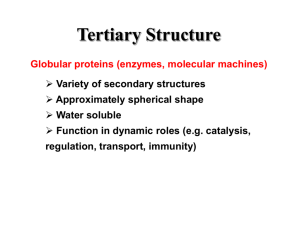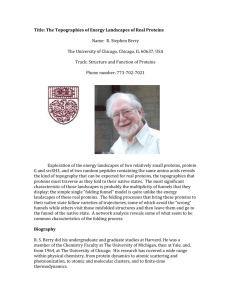Lecture #27 Exam 3: Lecture 27
advertisement
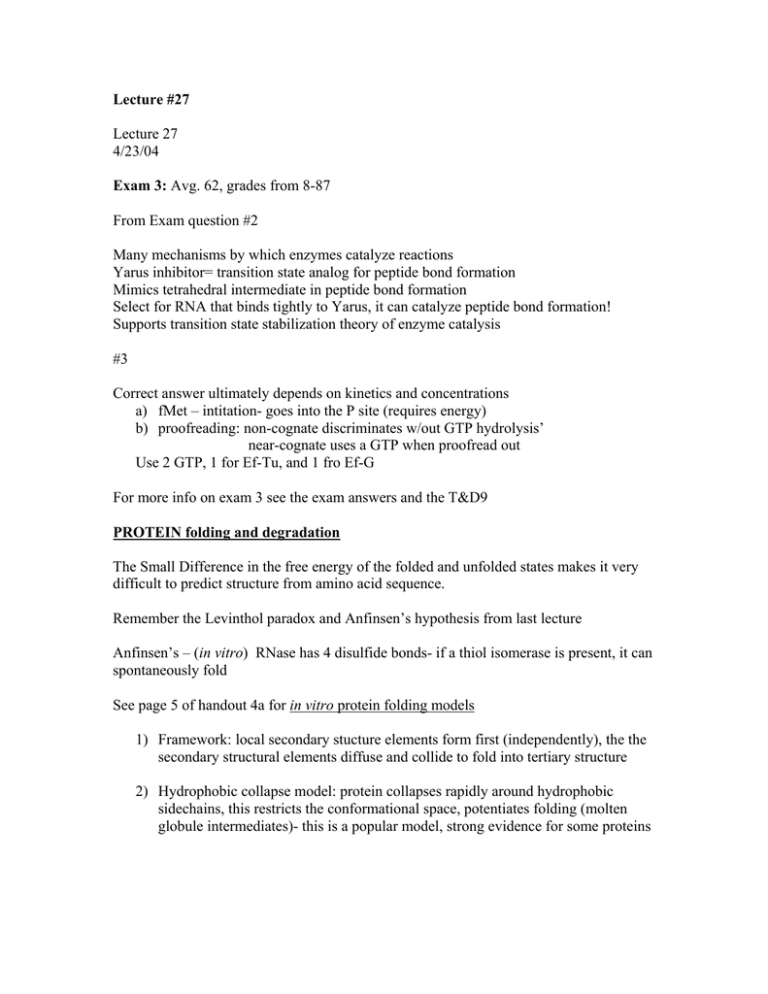
Lecture #27 Lecture 27 4/23/04 Exam 3: Avg. 62, grades from 8-87 From Exam question #2 Many mechanisms by which enzymes catalyze reactions Yarus inhibitor= transition state analog for peptide bond formation Mimics tetrahedral intermediate in peptide bond formation Select for RNA that binds tightly to Yarus, it can catalyze peptide bond formation! Supports transition state stabilization theory of enzyme catalysis #3 Correct answer ultimately depends on kinetics and concentrations a) fMet – intitation- goes into the P site (requires energy) b) proofreading: non-cognate discriminates w/out GTP hydrolysis’ near-cognate uses a GTP when proofread out Use 2 GTP, 1 for Ef-Tu, and 1 fro Ef-G For more info on exam 3 see the exam answers and the T&D9 PROTEIN folding and degradation The Small Difference in the free energy of the folded and unfolded states makes it very difficult to predict structure from amino acid sequence. Remember the Levinthol paradox and Anfinsen’s hypothesis from last lecture Anfinsen’s – (in vitro) RNase has 4 disulfide bonds- if a thiol isomerase is present, it can spontaneously fold See page 5 of handout 4a for in vitro protein folding models 1) Framework: local secondary stucture elements form first (independently), the the secondary structural elements diffuse and collide to fold into tertiary structure 2) Hydrophobic collapse model: protein collapses rapidly around hydrophobic sidechains, this restricts the conformational space, potentiates folding (molten globule intermediates)- this is a popular model, strong evidence for some proteins 3) Nucleation Model- neighboring residues adajacent in sequence space form some element of the native secondary structure, this structure acts as a nucleus for cooperative folding (no intermediates) 4) Jigsaw model- each molecule folds by a distinct pathway (need single molecule methods to test this theory) See page 6 of handout 4a for a description of different methods used to study protein folding Pay attention to timescales- each method has a different timescale associated with it Different proteins fold at different rates, small proteins can fold in ns-ms, RNase with all the disulfide bonds took hours Fluorescence, Circular Dichroism, IR, NMR, and Mass-spec(hydrogen/deuterium exchange) are all common methods used for studying protein folding in vitro Conclusion (from all studies, using a wide range of different methods)- There is no specific pathway, but a multidimensional landscape- called a folding funnel Some pathways are more populated than other(this is protein dependent- different proteins may take different pathways) (See diagram of this model on page 6 of handout 4a) Protein folding – in vitro vs. in vivo In the last five years we’ve learned that many proteins are actually unfolded in the cell! Think about timescales: In vitro : nsec to hrs –protein dependent In vivo : rate constant for peptide bond formation in E.coli is ~ 10-20 s-1 With a 300 amino acid protein on the ribosome, the half-life for folding as it comes out of the exit tunnel is ~30s (folding limited by rate of peptide bond formation) What are the conditions under which protein folding occurs?? In vitro: most studies of in vitro folding are done in the absence of other proteins in dilute conditions- avoid aggregation (very different from conditions inside the cell) Usually study small proteins In vivo : 340 mg/mL of macromolecules in bacteria Concentration of ribosome is 30-35 microM Concentration and kinetics are important!!! In vitro: no assistance in folding (except maybe beta-mercaptoethanol) In vivo: more complex Multi-domain proteins, sub-unit interactions A large repertoire of proteins are required Folding Process: in vivo (overview) a) Proylisomerase (inter-converts the cis/trans forms of proline) b) Disulfide bond formation: requires an oxidase to form disulfides isomerase to rearrange incorrect disulfides c) protein chaperones 1. Hsp70/Hsp40 (Heat shock protein- elevated when bacteria is under stress) “Holdases” or “unfoldases” (Use ATP) 2. Clp B/Hsp104- “deaggregases” 3. Chambers- GroEL/GroES- big chambers
